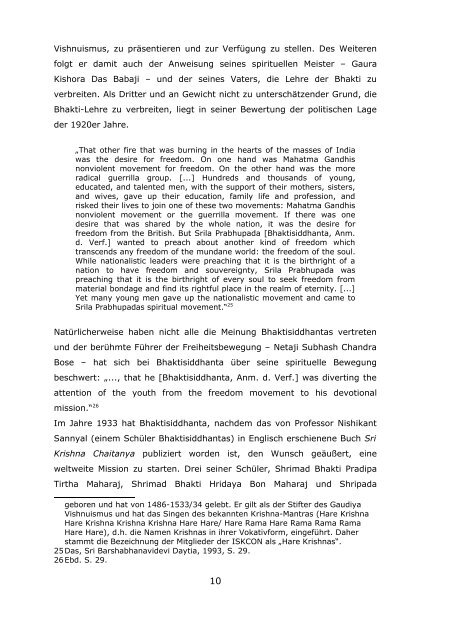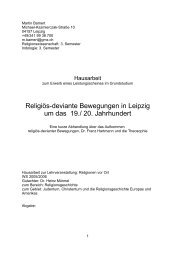ISKCON vs Narayan Maharaj.pdf - Martin Bamert
ISKCON vs Narayan Maharaj.pdf - Martin Bamert
ISKCON vs Narayan Maharaj.pdf - Martin Bamert
Erfolgreiche ePaper selbst erstellen
Machen Sie aus Ihren PDF Publikationen ein blätterbares Flipbook mit unserer einzigartigen Google optimierten e-Paper Software.
Vishnuismus, zu präsentieren und zur Verfügung zu stellen. Des Weiteren<br />
folgt er damit auch der Anweisung seines spirituellen Meister – Gaura<br />
Kishora Das Babaji – und der seines Vaters, die Lehre der Bhakti zu<br />
verbreiten. Als Dritter und an Gewicht nicht zu unterschätzender Grund, die<br />
Bhakti-Lehre zu verbreiten, liegt in seiner Bewertung der politischen Lage<br />
der 1920er Jahre.<br />
„That other fire that was burning in the hearts of the masses of India<br />
was the desire for freedom. On one hand was Mahatma Gandhis<br />
nonviolent movement for freedom. On the other hand was the more<br />
radical guerrilla group. [...] Hundreds and thousands of young,<br />
educated, and talented men, with the support of their mothers, sisters,<br />
and wives, gave up their education, family life and profession, and<br />
risked their lives to join one of these two movements: Mahatma Gandhis<br />
nonviolent movement or the guerrilla movement. If there was one<br />
desire that was shared by the whole nation, it was the desire for<br />
freedom from the British. But Srila Prabhupada [Bhaktisiddhanta, Anm.<br />
d. Verf.] wanted to preach about another kind of freedom which<br />
transcends any freedom of the mundane world: the freedom of the soul.<br />
While nationalistic leaders were preaching that it is the birthright of a<br />
nation to have freedom and souvereignty, Srila Prabhupada was<br />
preaching that it is the birthright of every soul to seek freedom from<br />
material bondage and find its rightful place in the realm of eternity. [...]<br />
Yet many young men gave up the nationalistic movement and came to<br />
Srila Prabhupadas spiritual movement.“ 25<br />
Natürlicherweise haben nicht alle die Meinung Bhaktisiddhantas vertreten<br />
und der berühmte Führer der Freiheitsbewegung – Netaji Subhash Chandra<br />
Bose – hat sich bei Bhaktisiddhanta über seine spirituelle Bewegung<br />
beschwert: „..., that he [Bhaktisiddhanta, Anm. d. Verf.] was diverting the<br />
attention of the youth from the freedom movement to his devotional<br />
mission.“ 26<br />
Im Jahre 1933 hat Bhaktisiddhanta, nachdem das von Professor Nishikant<br />
Sannyal (einem Schüler Bhaktisiddhantas) in Englisch erschienene Buch Sri<br />
Krishna Chaitanya publiziert worden ist, den Wunsch geäußert, eine<br />
weltweite Mission zu starten. Drei seiner Schüler, Shrimad Bhakti Pradipa<br />
Tirtha <strong>Maharaj</strong>, Shrimad Bhakti Hridaya Bon <strong>Maharaj</strong> und Shripada<br />
geboren und hat von 1486-1533/34 gelebt. Er gilt als der Stifter des Gaudiya<br />
Vishnuismus und hat das Singen des bekannten Krishna-Mantras (Hare Krishna<br />
Hare Krishna Krishna Krishna Hare Hare/ Hare Rama Hare Rama Rama Rama<br />
Hare Hare), d.h. die Namen Krishnas in ihrer Vokativform, eingeführt. Daher<br />
stammt die Bezeichnung der Mitglieder der <strong>ISKCON</strong> als „Hare Krishnas“.<br />
25 Das, Sri Barshabhanavidevi Daytia, 1993, S. 29.<br />
26 Ebd. S. 29.<br />
10



